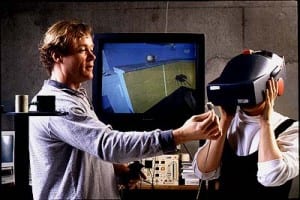Virtual Reality Immersion is the users experience of feeling as if being a part of the virtual world. The user should be able to interact with the virtual environment in meaningful, realistic ways. Producing a sense of virtual reality immersion with the ability to interact is also known as telepresence. This idea is defined as the extent that the user feels present in the virtual environment, instead of the real physical environment. This means that an effective virtual reality experience makes the user become unaware of their real surroundings and instead focused on the interaction within the virtual environment.
 The two main components of virtual reality immersion are depth of and breadth of information. The depth of information is the amount and quality of data the user is given during interacting with the virtual environment. This can refer to the display resolution, the complexity of graphics, and the clarity of audio output. Breadth of information is the number of sensory dimensions that are presented. To have a wide breadth of information, the virtual reality immersion must stimulates all the senses. Virtual reality immersion experiences prioritize audio and visual components over the other sensory factors. Scientists and engineers are studying ways to incorporate the sense of touch into virtual reality immersion. Known as haptic systems, they provide users feedback and touch interaction.
The two main components of virtual reality immersion are depth of and breadth of information. The depth of information is the amount and quality of data the user is given during interacting with the virtual environment. This can refer to the display resolution, the complexity of graphics, and the clarity of audio output. Breadth of information is the number of sensory dimensions that are presented. To have a wide breadth of information, the virtual reality immersion must stimulates all the senses. Virtual reality immersion experiences prioritize audio and visual components over the other sensory factors. Scientists and engineers are studying ways to incorporate the sense of touch into virtual reality immersion. Known as haptic systems, they provide users feedback and touch interaction.
For virtual reality immersion to be effective, users should have the ability to explore a life-sized VR environment. They need to freely and seamlessly change perspectives to view objects from any angle or point of view, shifting accordingly where ever the user might look. This is critical in order to create a convincing virtual reality immersion and user experience.
Virtual Reality Immersion and Environment
Sensory output should be able to adjust in real time as the user explores the virtual environment . To achieve virtual reality immersion the user must be convinced that the virtual environment behaves natural way as he maneuvers through it. Sensory stimulation from the virtual environment has to be consistent for the user experience immersion.
The difference between when a user acts and when the virtual environment responds to the action from the virtual environment is known as latency. This typically describes the delay between when the user turns the head or eyes and the virtual shift in point of view. It can also be describe a lag in with the other virtual sensory outputs. Flight simulators have shown that humans are able to detect latency of more than fifty milliseconds. As a user senses latency, it creates awareness of an artificial environment, which will destroy any feeling of virtual reality immersion.
Virtual reality immersion becomes lacking when the user has become aware of the real world. A truly virtual reality immersion causes users to forget their real environments, effectively making the computer a non-entity. To achieve true immersion, developers have to created input methods that feel more natural for the user. This can be successful as long as users are not aware of the interaction device.